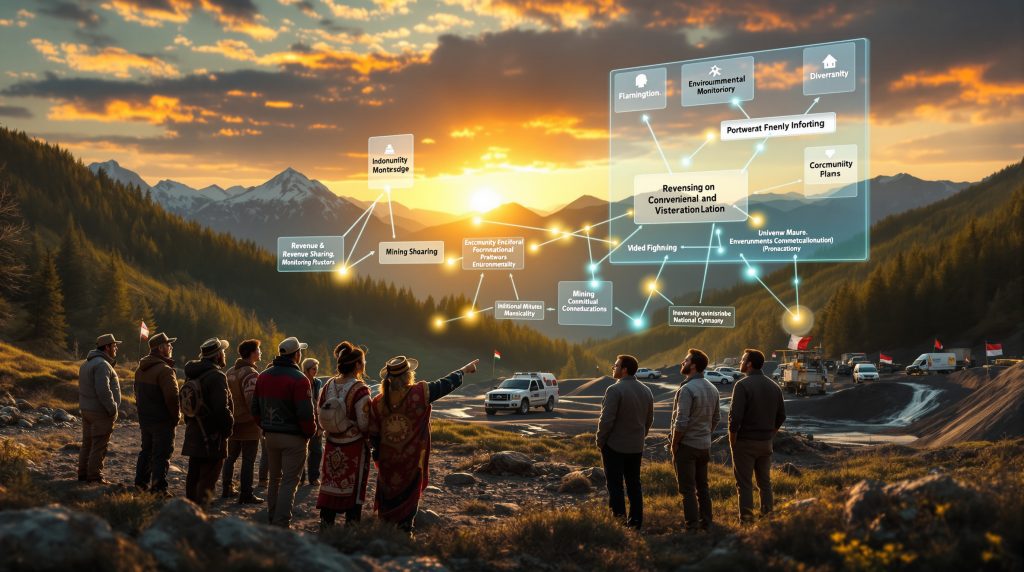How Has Indigenous Involvement in Mining Projects Evolved?
Indigenous participation in mining has transformed dramatically over recent decades, shifting from exclusion to partnership. Historically, Indigenous communities were often marginalized in resource development decisions affecting their traditional territories, receiving minimal benefits while bearing significant environmental and social costs.
Today, the relationship between Indigenous peoples and the mining sector is increasingly characterized by collaborative decision-making processes, equity ownership opportunities, revenue-sharing arrangements, employment and procurement preferences, cultural heritage protection mechanisms, and environmental stewardship partnerships.
This evolution reflects broader recognition of Indigenous rights and the business case for meaningful engagement with communities who hold deep connections to the land where mining industry evolution occurs.
The Raglan Agreement between Inuit communities and Falconbridge (now Glencore) stands as a pivotal milestone in this evolution. Established in 1995 and now celebrating its 30th anniversary, this pioneering agreement created a template for subsequent Impact Benefit Agreements across Canada and internationally, demonstrating how structured partnerships can deliver mutual benefits while respecting Indigenous rights.
From Exclusion to Partnership: A Historical Perspective
The evolution from exclusion to partnership in Indigenous-mining relations can be traced through three distinct phases:
-
Pre-1980s: An extraction-focused approach with minimal community engagement
-
1980s-2000s: A consultation-focused era following landmark court decisions
-
2000s-present: A partnership-oriented approach emphasizing equity participation and shared decision-making
This progression reflects broader legal developments including the recognition of Aboriginal title in cases such as Delgamuukw v. British Columbia (1997) and Tsilhqot'in Nation v. British Columbia (2014), which established stronger legal foundations for Indigenous rights in resource development.
Contemporary Indigenous Leadership in Mining
The recent Portland Canal Holdings joint venture exemplifies the latest evolution in Indigenous participation in mining. Formed in 2025 by the Nisga'a Nation, Tahltan Nation, and Arrow Transportation Systems, this historic partnership created British Columbia's first Indigenous-owned and operated deep-sea port terminal.
This landmark development illustrates how Indigenous nations are strategically positioning themselves within the broader mining value chain, moving beyond individual project participation to ownership of critical infrastructure that serves multiple mining operations.
According to Canadian Mining Journal research, Indigenous businesses generated approximately $12.5 billion in economic activity through relationships with the resource sector in 2024, demonstrating the growing economic impact of Indigenous participation in mining and related industries.
What Rights Do Indigenous Communities Have in Mining Development?
Free, Prior, and Informed Consent (FPIC)
FPIC represents a fundamental right of Indigenous peoples to determine what happens on their traditional territories. This principle requires that:
Free: Decisions must be made without coercion or manipulation
Prior: Consent must be sought before project approval or commencement
Informed: Communities must receive complete information about potential impacts
Consent: The right to approve or reject proposed developments
While international frameworks like the UN Declaration on the Rights of Indigenous Peoples (UNDRIP) recognize FPIC, implementation varies significantly across jurisdictions. Countries like Canada have established consultation requirements, though challenges remain in translating principles into consistent practice.
Legal scholar John Borrows has observed that "FPIC is not a veto right but a framework for procedural justice that requires meaningful engagement throughout the project lifecycle." This perspective emphasizes that FPIC focuses on process quality rather than simply project outcomes.
Legal Frameworks and Recognition
The legal standing of Indigenous rights in mining contexts differs globally:
| Region | Key Legal Frameworks | Implementation Status |
|---|---|---|
| Canada | Section 35 Constitution Act, UNDRIP legislation | Consultation required, implementation varies by province |
| Australia | Native Title Act, Indigenous Land Use Agreements | Established negotiation frameworks, ongoing challenges |
| Latin America | ILO Convention 169, national constitutions | Uneven implementation, social conflicts common |
| United States | Tribal sovereignty, federal trust responsibility | Consultation required on federal lands, gaps remain |
These frameworks create the foundation for Indigenous participation, though their effectiveness depends on political will, regulatory enforcement, and corporate commitment to meaningful engagement.
The Canadian legal framework has evolved through key court decisions that established the "honor of the Crown" principle requiring meaningful consultation rather than mere "going through the motions." The Haida Nation v. British Columbia (2004) decision established that the Crown's duty to consult exists on a spectrum proportional to the strength of the Indigenous claim and potential impacts of the proposed activity.
Implementation Challenges and Opportunities
Despite legal recognition, implementing Indigenous rights in mining contexts faces several challenges:
- Varying interpretation of consultation requirements across jurisdictions
- Capacity constraints within some Indigenous communities
- Power imbalances in negotiation processes
- Limited enforcement mechanisms for agreement compliance
- Differing perspectives on what constitutes meaningful engagement
As of 2025, approximately 80% of major mining projects in Canada involve some form of formal agreement with Indigenous communities, up from less than 20% in the early 2000s. This dramatic increase reflects both strengthened legal frameworks and growing recognition among mining companies of the business case for meaningful Indigenous partnerships.
What Economic Benefits Can Mining Partnerships Deliver?
Revenue Sharing and Equity Participation
Modern agreements between Indigenous communities and mining companies frequently include:
- Direct revenue-sharing arrangements (typically 1-5% of project profits)
- Equity ownership opportunities in mining operations
- Trust funds for community development
- Royalty payments based on production volumes
- Dividend structures tied to project performance
These financial mechanisms help ensure communities receive fair value for resource extraction while building long-term economic sustainability.
Recent agreements show revenue-sharing rates typically ranging from 1-5% of project profits, with some agreements reaching up to 7% for projects on traditional territories with established Aboriginal title. These rates reflect evolving standards of fair compensation for resource development impacts and benefits.
Employment and Business Development
Beyond direct financial benefits, mining partnerships can create:
- Preferential hiring policies with training programs
- Procurement targets for Indigenous businesses
- Joint ventures in mining services and logistics
- Capacity building initiatives for entrepreneurship
- Career advancement pathways in technical and management roles
The Portland Canal Holdings joint venture in British Columbia exemplifies this approach, with the Nisga'a Nation, Tahltan Nation, and Arrow Transportation Systems collaborating to acquire and operate the Port of Stewart bulk terminal—marking the first Indigenous-owned and operated deep-sea port terminal in the province's history.
This strategic acquisition, supported by $5 million in provincial government funding, demonstrates how Indigenous nations are positioning themselves as key players in the critical minerals energy transition rather than simply project participants.
Creating Sustainable Economic Foundations
Economist Carol Anne Caughey emphasizes that "long-term sustainability requires moving beyond percentage-based revenue sharing to equity participation models that build Indigenous ownership capacity across the mining value chain."
Indigenous businesses generated approximately $12.5 billion in economic activity through relationships with the Canadian resource sector in 2024, up from $4.1 billion in 2016. This threefold increase demonstrates the growing economic impact of Indigenous participation in mining and related industries.
Effective economic benefit structures in modern Indigenous-mining partnerships commonly include:
-
Direct financial benefits:
- Revenue sharing formulas (often tied to net profits rather than gross revenue)
- Royalty payments (typically 0.5-2% of gross value)
- Equity participation (5-30% ownership stakes)
-
Employment access provisions:
- Targeted hiring goals (20-50% of workforce)
- Skills training pipelines with guaranteed employment
- Leadership development programs
-
Business development mechanisms:
- Procurement targets (10-25% of project contracting)
- Joint venture structures for mine services
- Business incubation funding
How Do Impact Benefit Agreements Structure Indigenous Partnerships?
Key Components of Effective IBAs
Comprehensive agreements typically address:
- Environmental monitoring and management
- Cultural heritage protection protocols
- Employment and training commitments
- Business development opportunities
- Revenue sharing formulas
- Dispute resolution mechanisms
- Closure and mine reclamation evolution planning
Over 70% of new major mining projects in Canada now include formal Impact Benefit Agreements with Indigenous communities, compared to less than 30% in 2005. This significant increase reflects both strengthened legal frameworks and growing recognition among mining companies of the business case for meaningful Indigenous partnerships.
The Raglan Agreement: A Pioneering Model
The 1995 Raglan Agreement between Inuit communities in northern Quebec and Falconbridge (now Glencore) represents a landmark in Indigenous-mining relations. Negotiated by Charlie Arngak while serving as mayor of Kangiqsujuaq, this pioneering agreement:
- Established profit-sharing mechanisms (up to 4.5% of operating profits)
- Created joint environmental oversight committees
- Prioritized Inuit employment and training
- Implemented cultural protection measures
- Developed post-mining sustainability planning
Now celebrating its 30th anniversary, the Raglan Agreement created a template for subsequent IBAs across Canada and internationally, demonstrating how structured partnerships can deliver mutual benefits while respecting Indigenous rights.
Structural Elements of Modern IBAs
Contemporary Impact Benefit Agreements typically include these structural components:
-
Governance Framework:
- Joint committees with decision-making authority
- Dispute resolution mechanisms
- Clear delineation of responsibilities
-
Financial Components:
- Formula-based revenue sharing
- Implementation funding for community administration
- Audit and transparency provisions
-
Social and Environmental Provisions:
- Cultural heritage protection protocols
- Environmental monitoring systems
- Closure and reclamation planning
According to David O'Fish, former Vice President of Growth and Strategy at a major resource company, "The most successful IBAs account for the entire project lifecycle, from exploration through closure, rather than focusing only on the operational phase."
Mine development projects involving Indigenous communities typically have 3-5 year negotiation periods for Impact Benefit Agreements, with larger projects requiring up to 7 years. This extended timeline reflects the complexity of balancing community needs, corporate interests, and long-term sustainability considerations.
What Environmental Stewardship Roles Do Indigenous Communities Play?
Traditional Knowledge Integration
Indigenous communities bring invaluable ecological knowledge to mining partnerships:
- Multi-generational understanding of local ecosystems
- Seasonal patterns and wildlife behavior insights
- Early warning indicators of environmental change
- Holistic approaches to environmental management
- Cultural context for land and water protection
When properly integrated with scientific monitoring, this traditional knowledge enhances environmental management and helps identify potential issues before they become significant problems.
Environmental scientist Dr. Deborah McGregor, Canada Research Chair in Indigenous Environmental Justice, states that "Traditional Knowledge provides critical information about ecosystem relationships and change indicators that Western science often misses, particularly regarding cumulative effects and long-term trends."
Collaborative Environmental Monitoring
Effective partnerships implement:
- Joint environmental oversight committees
- Indigenous Guardian programs
- Community-based monitoring initiatives
- Traditional knowledge documentation projects
- Independent environmental review mechanisms
These collaborative approaches improve environmental outcomes while building trust between communities and companies through transparent information sharing and joint problem-solving.
Over 60 Indigenous Guardian programs now operate across Canada, with participation from more than 200 First Nations communities, representing a 150% increase since 2017. These programs employ community members to monitor environmental conditions and ensure compliance with regulatory requirements.
Mining projects with formal Indigenous environmental monitoring partnerships have demonstrated 25% faster identification of potential environmental issues compared to traditional monitoring alone. This improved detection capability stems from combining scientific methods with traditional knowledge of ecosystem relationships and baseline conditions.
Environmental Protection Through Traditional Knowledge
Approximately 75% of major mining projects in Canada completed since 2015 include references to Indigenous Traditional Knowledge in their environmental assessment documentation. This integration represents a significant shift from earlier approaches that relied exclusively on Western scientific methodologies.
The Raglan Agreement pioneered many elements of collaborative environmental management, particularly in establishing joint environmental oversight committees that have operated continuously for 30 years. These committees bring together Inuit knowledge holders and scientific experts to monitor environmental conditions and address concerns proactively.
What Challenges Remain in Indigenous-Mining Relationships?
Implementation Gaps
Despite progress in establishing frameworks for Indigenous participation, significant challenges persist:
- Inconsistent application of consultation standards
- Capacity limitations in some communities
- Power imbalances in negotiation processes
- Varying levels of corporate commitment
- Regulatory enforcement challenges
- Legacy issues from historical projects
Legal expert Bradford Morse notes that "IBAs function best when they respect both the legal framework of the jurisdiction and the Indigenous governance structure, creating parallel systems of accountability." When either system is undermined, implementation challenges multiply.
Balancing Development and Cultural Preservation
Indigenous communities often face difficult decisions balancing:
- Economic development opportunities
- Traditional land use practices
- Cultural heritage protection
- Environmental conservation
- Community cohesion
These tensions require thoughtful dialogue and respect for each community's right to determine its own development priorities and pace of change.
The implementation of Free, Prior, and Informed Consent principles varies significantly across jurisdictions, with some regions having stronger legal frameworks than others. Even within countries like Canada, significant differences exist between provincial approaches to Indigenous consultation and consent.
Dalee Sambo Dorough, International Chair of the Inuit Circumpolar Council, has noted that "effective implementation of FPIC requires recognition of Indigenous governance structures and decision-making processes that may differ from Western models." This cultural dimension of consultation remains a challenge in many mining contexts.
Addressing Historical Inequities
Many mining regions face complex challenges stemming from historical exclusion of Indigenous communities:
- Legacy environmental issues from past mining activities
- Unresolved land claims overlapping with mineral tenures
- Intergenerational impacts of previous resource development
- Mistrust based on historical experiences
- Limited participation in earlier economic benefits
Addressing these historical inequities requires acknowledgment of past harms and commitment to new partnership models that center Indigenous rights and interests.
How Are Indigenous-Owned Mining Ventures Reshaping the Industry?
Indigenous Leadership in Resource Development
Beyond participation in externally-owned projects, Indigenous communities are increasingly developing their own mining initiatives:
- Wholly-owned mining operations
- Majority stakes in joint ventures
- Indigenous mining service companies
- Community-led mineral exploration importance programs
- Strategic partnerships with established miners
These Indigenous-led ventures represent a significant evolution from reactive participation to proactive resource development aligned with community values and priorities.
According to Steven Wilson from the University of Saskatchewan, "Successful Indigenous-mining partnerships generate economic benefits that extend beyond direct revenue sharing to include human capital development, business diversification, and intergenerational wealth transfer."
Case Study: Indigenous Port Ownership in British Columbia
The recent acquisition of the Port of Stewart bulk terminal by the Nisga'a Nation, Tahltan Nation, and Arrow Transportation Systems demonstrates Indigenous leadership in critical minerals infrastructure. This historic joint venture:
- Creates the first Indigenous-owned and operated deep-sea port in B.C.
- Streamlines transportation of minerals from mines in Indigenous territories
- Merges regional trucking operations for improved efficiency
- Received $5 million in provincial government support
- Establishes Indigenous control over a key link in the mineral supply chain
This landmark development illustrates how Indigenous nations are strategically positioning themselves within the broader mining value chain, moving beyond individual project participation to ownership of critical infrastructure.
Strategic Position in Critical Minerals Supply Chains
Indigenous businesses generated approximately $12.5 billion in economic activity through relationships with the Canadian resource sector in 2024, up from $4.1 billion in 2016. This threefold increase demonstrates the growing economic impact of Indigenous participation in mining and related industries.
The acquisition of the Port of Stewart bulk terminal represents a significant evolution from project-specific agreements to ownership of critical mineral supply chain infrastructure. This strategic positioning allows Indigenous nations to capture value from multiple mining operations rather than relying on individual project agreements.
What Does Meaningful Consultation Look Like in Practice?
Beyond Checkbox Compliance
Meaningful consultation requires:
- Early engagement before major decisions
- Sufficient time for community deliberation
- Transparent information sharing
- Respect for Indigenous governance structures
- Willingness to modify plans based on feedback
- Ongoing dialogue throughout project lifecycle
The Canadian legal framework has evolved through key court decisions that established the "honor of the Crown" principle requiring meaningful consultation rather than mere "going through the motions." The Haida Nation v. British Columbia (2004) decision established that the Crown's duty to consult exists on a spectrum proportional to the strength of the Indigenous claim and potential impacts of the proposed activity.
Establishing Consent Protocols
Progressive companies and communities are developing formal protocols that:
- Define what constitutes consent
- Establish clear decision-making processes
- Document consultation activities
- Identify key decision points
- Create mechanisms for ongoing review
- Respect Indigenous governance structures
These protocols help prevent misunderstandings and establish clear expectations for all parties throughout the mining lifecycle.
The Deh Cho Process developed between the Government of the Northwest Territories and the Deh Cho First Nations has become a model for Indigenous-led consultation frameworks. This process establishes clear protocols for information sharing, decision-making timelines, and incorporation of traditional knowledge in resource development decisions.
Consultation as Relationship Building
Effective consultation goes beyond regulatory compliance to build lasting relationships based on:
- Mutual respect for different knowledge systems
- Recognition of Indigenous governance authority
- Commitment to ongoing dialogue beyond decision points
- Flexibility to adapt approaches based on community feedback
- Investment in building trust through consistent engagement
- Transparency in sharing information and addressing concerns
As one Indigenous leader expressed, "Consultation isn't a single meeting or a checked box—it's an ongoing conversation about our shared future on the land."
How Can Mining Companies Build Authentic Indigenous Relationships?
Cultural Competency Development
Successful companies invest in:
- Cultural awareness training for all staff
- Understanding of specific community protocols
- Respect for traditional decision-making processes
- Recognition of the diversity among Indigenous groups
- Long-term relationship building beyond transactional engagement
Mining projects with formal Indigenous environmental monitoring partnerships have demonstrated 25% faster identification of potential environmental issues compared to traditional monitoring alone. This improved detection capability stems from combining scientific methods with traditional knowledge of ecosystem relationships and baseline conditions.
Long-Term Commitment Indicators
Actions that demonstrate authentic commitment include:
- Consistent senior leadership involvement
- Indigenous representation in governance structures
- Transparent reporting on agreement implementation
- Willingness to adapt approaches based on feedback
- Investment in community priorities beyond direct project needs
- Support for Indigenous self-determination
These commitment indicators help distinguish companies genuinely interested in partnership from those merely seeking regulatory compliance or social license.
The most successful Indigenous-mining partnerships recognize that relationship building takes time and extends beyond the boundaries of specific projects. Companies with sustained positive relationships typically demonstrate patience, cultural humility, and willingness to invest in relationship building before advancing specific project interests.
What Future Trends Will Shape Indigenous-Mining Partnerships?
Evolving Standards and Expectations
The landscape continues to evolve with:
- Strengthening international standards for Indigenous engagement
- Growing investor scrutiny of company-community relationships
- Increasing Indigenous ownership across the value chain
- Enhanced regulatory requirements in many jurisdictions
- Rising expectations for meaningful partnership models
These trends suggest that Indigenous participation in mining will continue to deepen, with communities playing increasingly central roles in project governance, environmental management, and economic benefit distribution.
Critical Minerals and Energy Transition Opportunities
The global push for critical minerals presents both challenges and opportunities:
- Increased demand for minerals on traditional territories
- Potential for new partnership models in emerging sectors
- Indigenous participation in clean energy supply chains
- Opportunities to address historical inequities
- Balance between development pressure and community priorities
Northern Graphite's Lac des Îles mine in Quebec, currently North America's only operating graphite mine, recently received up to $6.2 million from Natural Resources Canada to extend its operational life by seven to ten years. This investment will preserve 55 existing jobs while maintaining production of a critical mineral essential for battery manufacturing and clean energy technologies.
Indigenous Leadership in Mining Innovation
Looking ahead, Indigenous communities are increasingly positioned to lead innovation in:
- Environmentally sustainable mining sustainability transformation practices
- Community-centered development models
- Integration of traditional and scientific knowledge
- Collaborative governance structures
- Long-term planning for post-mining land use
These innovations offer potential benefits not only for Indigenous communities but for the broader mining sector as it navigates growing expectations for social responsibility and environmental performance.
FAQ: Indigenous Participation in Mining
How do mining agreements benefit Indigenous communities economically?
Mining agreements typically provide communities with revenue sharing (often 1-5% of profits), preferential employment opportunities, business development support, education and training programs, and infrastructure investments. The specific benefits vary by agreement, with some also including equity ownership in projects or related infrastructure.
What role do Indigenous communities play in environmental monitoring?
Indigenous communities often participate in environmental oversight through joint monitoring committees, independent review processes, and integration of traditional ecological knowledge. Many agreements establish Indigenous Guardian programs that employ community members to monitor environmental conditions and ensure compliance with regulatory requirements.
How can mining companies effectively engage with Indigenous communities?
Effective engagement requires early consultation before project planning, respect for Indigenous governance structures, cultural competency training for staff, transparent information sharing, and willingness to adapt plans based on community feedback. Companies should recognize that relationship-building takes time and extends beyond regulatory requirements.
What makes the Raglan Agreement significant in Indigenous-mining relations?
The 1995 Raglan Agreement between Inuit communities and Falconbridge (now Glencore) pioneered comprehensive benefit-sharing in Canada, establishing profit-sharing mechanisms, environmental oversight committees, employment priorities, and cultural protection measures. Now in its 30th year, it created a template for subsequent Impact Benefit Agreements worldwide.
How are Indigenous communities participating in the critical minerals supply chain?
Indigenous participation in critical minerals extends from mining operations to transportation infrastructure and processing facilities. The Portland Canal Holdings joint venture in British Columbia exemplifies this trend, with Indigenous nations acquiring and operating a deep-sea port terminal that facilitates the movement of critical minerals from mines in their traditional territories.
What legal frameworks support Indigenous participation in mining?
Legal frameworks vary globally but include constitutional protections (like Section 35 in Canada), international agreements (like UNDRIP and ILO Convention 169), national legislation (like Australia's Native Title Act), and case law establishing consultation requirements. The effectiveness of these frameworks depends on implementation and enforcement.
Conclusion: Toward Genuine Partnership in Mining
The evolution of Indigenous participation in mining represents one of the most significant transformations in the global mining industry over the past three decades. From historical marginalization to emerging models of equity partnership and infrastructure ownership, Indigenous communities are reshaping how mining contributes to sustainable development.
As the critical minerals transition accelerates global demand for minerals often found on Indigenous territories, the quality of Indigenous-mining partnerships will increasingly determine both project success and community wellbeing. The most successful partnerships will combine respect for Indigenous rights, meaningful economic participation, and shared environmental stewardship.
The experiences of communities like those involved in the Raglan Agreement and the Portland Canal Holdings joint venture demonstrate that when Indigenous rights and interests are centered in mining development, both communities and companies can benefit. The challenge ahead lies in extending these partnership models to more regions and ensuring they deliver long-term sustainable outcomes for all involved.
Disclaimer: This article discusses general trends in Indigenous participation in mining and is not intended as investment advice. Specific mining projects and companies mentioned are provided as examples only. Readers should conduct their own research before making investment decisions related to any mining venture.
Wondering How to Identify the Next Major Mineral Discovery?
Gain immediate, real-time alerts on significant ASX mineral discoveries with Discovery Alert's proprietary Discovery IQ model, translating complex mineral data into actionable investment insights. Explore why historic discoveries can generate substantial returns by visiting Discovery Alert's dedicated discoveries page and position yourself ahead of the market with your 30-day free trial.




